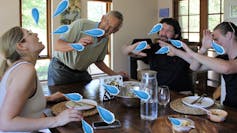what is contact tracing and how does it help limit the coronavirus spread?
- Written by Michael Bret Hart, Adjunct Clinical Associate Professor Curtin Medical School Public Health Physician, Curtin University
You might have heard about contact tracing which, when combined with social distancing, has proven a powerful asset in controlling the spread of COVID-19.
In short, it means assigning a “contact tracer” to interview each person with a confirmed case of COVID-19. The contact tracer, through painstaking and quick detective work, finds out who else might have already acquired the virus from the infectious person, or been exposed.
“Close contacts” of a person who might have COVID-19 can then be isolated (if sick) or quarantined (if well) to lessen further spread of the virus. The contact tracer will be especially interested in any contact who may be in a higher-risk group, such as older or immuno-compromised people.
This technique has also been used to better understand and limit the spread of HIV, meningitis and other diseases. It is a powerful tool discovered almost a century ago to limit the spread of sexually transmitted infections from and to American troops.
Read more: How do we detect if coronavirus is spreading in the community?
Close contacts
The COVID-19 virus is located in the respiratory tract and is spread when someone coughs or sneezes, dispersing infected droplets like a scatter gun.
 One sneeze or cough can spread infected droplets everywhere, even onto surfaces that people may touch later.
Michael Bret Hart, Author provided
One sneeze or cough can spread infected droplets everywhere, even onto surfaces that people may touch later.
Michael Bret Hart, Author provided
Several people can be infected from one COVID-19 positive person, even by later entering a room and touching contaminated objects.
So contact tracing under these circumstances is challenging. The droplet spreader will have to recall his or her movements carefully.
The contact tracer will be especially interested to know:
- who has this confirmed case met or talked with recently? Was it inside or outside?
- who have they sat near, for example in a lecture hall or other enclosed space?
- have they been to a big event like a footy match?
Queensland Health succinctly summarises the procedure, in accordance with the Communicable Disease Network Australia guidelines, saying:
Close contacts are those who have had face-to-face contact with a confirmed case for a period more than 15 minutes, or those who have shared an enclosed space with a confirmed case for more than two hours.
We are not looking for people the person may have passed on the street or in a shop, as the risk in these situations is extremely low.
If you have been in close contact with someone who has a confirmed case of novel coronavirus you need to self-quarantine for 14 days from your last contact with them. If you become unwell during that period, see a doctor immediately.
And here’s how Singapore explains their contact tracing process, well-honed by previous experience managing Severe Acute Respiratory Syndrome (SARS) and H1N1 influenza (sometimes called bird flu):
To facilitate the process, Victoria is using a new text messaging system to monitor close contacts.
It needs to be done right
If the contact tracing process was applied to every COVID-19 case, it would help reduce (but not completely stop) the spread of the coronavirus. It’s important to remember that possibly less than half of all infected people are symptomatic. Contact tracing could help find those people and ask them to self-isolate.
It’s also important to ensure we have enough testing kits to keep up. Our testing rate is currently one of the highest in the world and ensuring a steady supply of testing kits is crucial as the virus spreads.
In the real world, however, the effectiveness of contact tracing depends on the skills, extent and capacity of the contact tracing workforce as well as compliance with the contact tracers’ advice.
Wuhan, with a population about half that of Australia, had more than 1800 teams of epidemiologists, with a minimum of five people per team, who traced tens of thousands of contacts a day. Previous reviews of health workforce capacity suggest that Australia is not so well resourced, which is why the Australian Defence Force is helping here.
Contact tracing and isolation are our two most important assets in the effort to limit the spread of coronavirus, so we need to ensure contact tracing teams are well resourced.
Authors: Michael Bret Hart, Adjunct Clinical Associate Professor Curtin Medical School Public Health Physician, Curtin University



